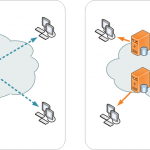HTTP/3 is the latest version of the HTTP (Hypertext Transfer Protocol) protocol, which is used for communication between web browsers and servers on the internet. It is an improvement over the previous version, HTTP/2, and offers several advantages over it.
One of the main advantages of HTTP/3 is that it uses a new transport protocol, QUIC (Quick UDP Internet Connections), which is built on top of the User Datagram Protocol (UDP) instead of the Transmission Control Protocol (TCP) used in HTTP/2. This allows for faster and more efficient communication between web browsers and servers.

QUIC is designed to reduce the number of round trips required for a browser to establish a connection with a server, which results in faster page load times. It also includes built-in error correction, which means that if a packet is lost, it can be retransmitted without having to wait for the browser to request it again. This further improves the speed and efficiency of the connection.
Another advantage of HTTP/3 is that it allows for multiplexing, which means that multiple requests can be sent and received at the same time over a single connection. This is an improvement over HTTP/2, which required a separate connection for each request. Multiplexing allows for faster and more efficient communication between the browser and server, resulting in faster page load times.
HTTP/3 also has improved security features. It uses the same encryption as HTTPS, which means that all communication between the browser and server is encrypted. This makes it more difficult for hackers to intercept and read the data being transmitted. Additionally, HTTP/3 also includes built-in support for 0-RTT (zero round-trip time) connections, which allows for faster and more secure connections.
Another advantage of HTTP/3 is that it is designed to work well in high-latency and unreliable network environments, such as mobile networks. This is because QUIC can adapt to changes in network conditions, such as packet loss and congestion, and adjust its behavior accordingly. This results in more consistent and reliable communication between the browser and server, even in challenging network environments.
One more advantage of HTTP/3 is that it reduces the load on the servers, as it uses fewer resources to establish a connection and send data. This means that servers can handle more requests and traffic, which can help to improve the scalability of web applications.
In conclusion, HTTP/3 offers several advantages over HTTP/2 and other previous versions of the HTTP protocol. These include faster and more efficient communication between web browsers and servers, improved security, and better performance in high-latency and unreliable network environments. These improvements can lead to faster page load times, more consistent and reliable communication, and better scalability for web applications. With the increasing adoption of HTTP/3, web developers can expect to see improved performance for their applications and a better user experience for their users.







